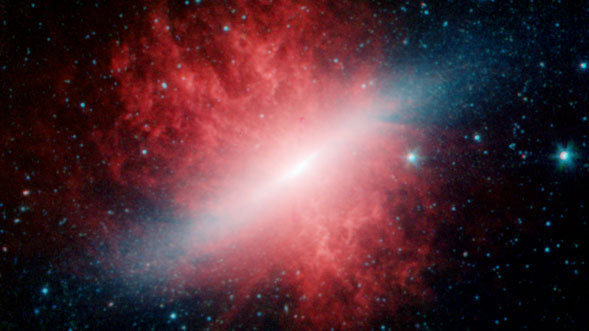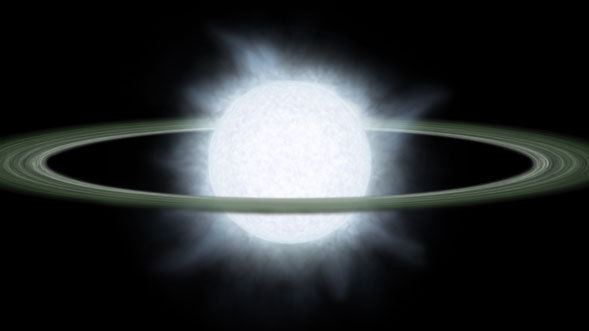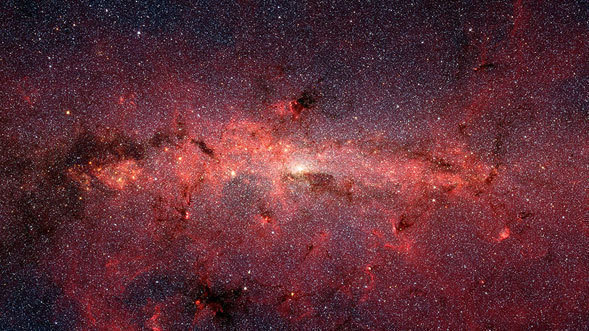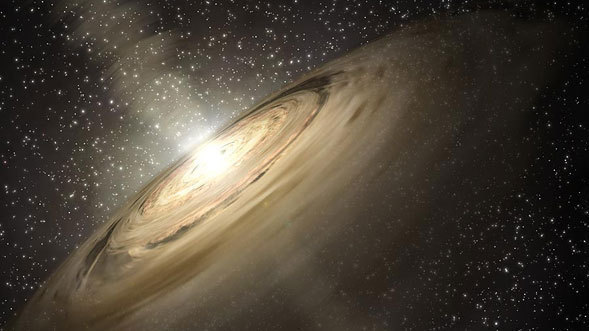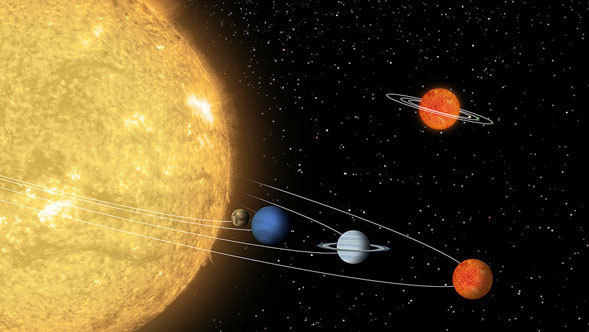Displaying news 481 - 510 of 587 in total
Paper trails and DNA tests will not help nearby elliptical galaxies find their galactic ancestors. However, an identification technique recently developed by astronomers using NASA's Spitzer Space Telescope is proving to be very successful in recognizing what could be the predecessors of modern elliptical galaxies.
Astronomers using NASA's Spitzer Space Telescope have conducted a cosmic safari to seek out a rare galactic species. Their specimens -- clusters of galaxies in the very distant universe -- are few and far between, and have hardly ever been detected beyond a distance of 7 billion light-years from Earth.
Where there's smoke, there's fire -- even in outer space. A new infrared image from NASA's Spitzer Space Telescope shows a burning hot galaxy whose fiery stars appear to be blowing out giant billows of smoky dust.
The California Institute of Technology announced today (March 15) that a team of astronomers, led by Carl Grillmair of the Spitzer Science Center, has discovered a narrow stream of stars extending at least 45 degrees across the northern sky.
University of California, Los Angeles
The components of life may have been under attack in the hostile environments of the universe's first galaxies, say astronomers using NASA's Spitzer Space Telescope.
This false-color composite image of the Stephan's Quintet galaxy cluster clearly shows one of the largest shock waves ever seen (green arc), produced by one galaxy falling toward another at over a million miles per hour. It is made up of data from NASA's Spitzer Space Telescope and a ground-based telescope in Spain.
Five recent PhDs have just been offered the chance of a lifetime. They have been given three years to focus solely on their Spitzer-related research interests, access to Spitzer Science Center resources, and the option to work at a world-class US-based institution of their choice. Best of all, they'll be getting paid, thanks to the Spitzer Space Telescope Postdoctoral Fellowship program.
For Release: February 21, 2006
NASA's Spitzer Space Telescope has observed a rare population of colliding galaxies whose entangled hearts are wrapped in tiny crystals resembling crushed glass.
Among the thousands of top interdisciplinary scientists, policy makers, journalists, and general science enthusiasts who are gathering in St. Louis, Mo. from February 16-20 for the 2006 American Association for the Advancement of Science (AAAS) meeting is Spitzer Space Telescope Project Scientist Dr. Michael Werner.
NASA's Spitzer Space Telescope has identified two huge "hypergiant" stars circled by monstrous disks of what might be planet-forming dust. The findings surprised astronomers because stars as big as these were thought to be inhospitable to planets.
When Doreen Spitzer learned that her son was going to visit the science center named after her late husband, Dr. Lyman Spitzer, Jr., she asked for two things: a Spitzer Space Telescope calendar and a comprehensive report of the visit.
Dr. Edward Tedesco may not play a musical instrument and has yet to release an album, but that does not mean he isn't a "rock star."
NASA's Spitzer Space Telescope has spotted what may be comet dust sprinkled around the white dwarf star G29-38, which died approximately 500 million years ago.
Harvard-Smithsonian Center for Astrophysics
National Optical Astronomy Observatory
A new infrared mosaic from NASA's Spitzer Space Telescope offers a stunning view of the stellar hustle and bustle that takes place at our Milky Way galaxy's center. The picture shows throngs of mostly old stars, on the order of hundreds of thousands, amid fantastically detailed clouds of glowing dust lit up by younger, massive stars.
Call it the Bermuda Triangle of our Milky Way Galaxy: a tiny patch of sky that has been known for years to be the source of the mysterious blasts of X-rays and gamma rays. Now, a team of astronomers, led by Don Figer of the Space Telescope Science Institute (STScI) in Baltimore, Md., has solved the mystery by identifying one of the most massive star clusters in the galaxy. The little-known cluster, which has not been catalogued, is about 20 times more massive than typical star clusters in our galaxy, and appears to be the source of the powerful outbursts.
The Helix Nebula (NGC 7293) is a challenging stargazing target for amateur astronomers. It is one of the closest planetary nebulas -- a type of nebula formed from gas ejected by a dying sunlike star. Yet it is so large and spread out in the sky that it appears very dim in a telescope eyepiece. Long-exposure photographs unveil the true beauty of this celestial wonder. A new portrait of the Helix Nebula, created by the penetrating infrared gaze of NASA's Spitzer Space Telescope, is being released today at the 207th meeting of the American Astronomical Society.
The "Christmas Tree Cluster" has been seen sporting a shiny new decoration: an ornament made of newborn stars! But like a gift-wrapped package, these newborn stars are hiding behind thick branches of cosmic dust, only revealed in this spectacular new image from NASA's Spitzer Space Telescope. Astronomers say this stellar ornament represents the best laboratory to date for studying the physics of star formation.
NASA's Spitzer Space Telescope has discovered some of life's most basic ingredients in the dust swirling around a young star. The ingredients -- gaseous precursors to DNA and protein -- were detected in the star's terrestrial planet zone, a region where rocky planets such as Earth are thought to be born.
Astronomers have at last found inner light! Only, they didn't find it through the typical Earthly methods of meditation, exercise and therapy. Instead, the light was discovered inside our Milky Way galaxy after hours of deep self-reflection with NASA's Spitzer Space Telescope.
After more than a year of training workshops, writing proposals, observing, and analyzing data, 12 middle and high school science teachers will culminate months of hard work with a booth presentation at astronomy's version of the Olympics, the American Astronomical Society (AAS) meeting, next month in Washington DC.
NASA's Spitzer Space Telescope is bringing new light -- infrared light -- to the study of our dark and mysterious universe. Some of the observatory's most exciting discoveries will be discussed in free public lectures on Thursday, Dec. 8 and Friday, Dec. 9.
When galaxies collide (as our galaxy, the Milky Way, eventually will with the nearby Andromeda galaxy), what happens to matter that gets spun off in the collision's wake?
Planets are everywhere these days. They have been spotted around more than 150 stars, and evidence is growing that they also circle "failed," or miniature, stars called brown dwarfs. Now, astronomers using NASA's Spitzer Space Telescope say they have found what may be planets-in-the-making in the strangest of places -- around a brown dwarf that itself is the size of a planet.
How many stars are currently forming in our Milky Way galaxy? How many of them are high-mass stars? These are questions a team of international astronomers will attempt to answer in a 417-hour galactic survey called MIPSGAL. Data from the project's first 200 hours of observations were just recently released to the astronomical community.
Harvard-Smithsonian Center for Astrophysics
Located 1,000 light-years from Earth in the constellation Perseus, a reflection nebula called NGC 1333 epitomizes the beautiful chaos of a dense group of stars being born. Most of the visible light from the young stars in this region is obscured by the dense, dusty cloud in which they formed. With NASA's Spitzer Space Telescope, scientists can detect the infrared light from these objects. This allows a look through the dust to gain a more detailed understanding of how stars like our sun begin their lives.
Displaying news 481 - 510 of 587 in total


